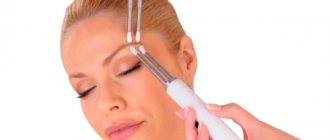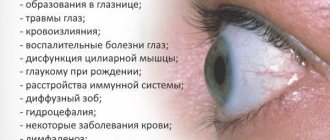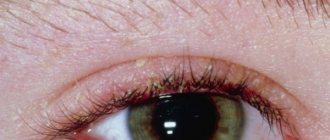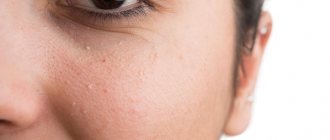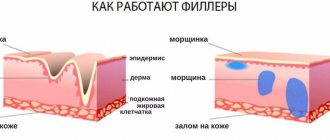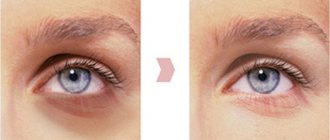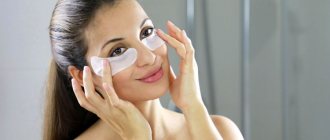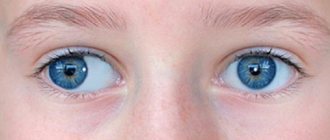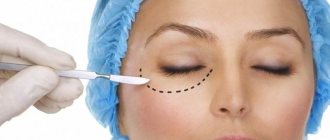Eyes are the mirror of the soul. By their appearance and condition, you can find out not only what kind of mood a person is in, but also understand something about his state of health. Not only the eyeball plays an important role, but also the skin around the organs of vision. A fairly common problem at any age is bags under the eyes, which are formed due to the accumulation of fluid due to fatigue or lack of sleep. In this case, just rest well and everything will pass.
But if even after rest nothing has gone away, but on the contrary, the situation only gets worse over time, then this could be a hernia of the eyelid. With this disease, fatty deposits accumulate in the subcutaneous space, forming a kind of protruding swelling. Such swelling can form not only on the lower, but also on the upper eyelid.
What kind of disease is this?
The tissue structure of the eyelids contains virtually no subcutaneous tissue. As a result of the influence of a number of factors (heredity, individual structural features of the body, frequent blinking, and so on), the skin of the eyelids can be subject to pathological stretching. This leads to excess space appearing under the skin of the eyelids, which gradually increases and is filled with pathological fatty (lipid) tissue. This is how a bulge appears, which is called a hernia of the eyelid or an eye hernia.
Ocular hernias most often form in the area of the lower eyelid, which is why they are often mistaken for ordinary under-eye bags. But neoplasms can also be localized on the upper eyelids. This accumulation of fat is a cosmetic defect, but also causes discomfort and can negatively affect vision. Therefore, it is recommended to detect and repair the hernia as early as possible.
Hernia of the eyelid - what is it?
A hernia of the upper or lower eyelid is a space filled with fatty deposits under the skin.
Important! This phenomenon occurs mainly in cases where the patient experiences stretching of the skin of the eyelid.
At the same time, frequent and constant blinking aggravates the situation, as the skin of the eyelid becomes flabby and loses its tone.
As a result, the subcutaneous space is cleared of healthy cells, making room for fat deposits.
This disease is also called “perioorbital hernia.”
This is not only an unaesthetic and unsightly defect , but also one of the reasons why blood circulation in the vascular system of the eyeball may be impaired .
Ultimately, this can lead to the formation of puffiness on the face, the appearance of edema and various tumors.
Causes
Most often, eyelid hernias appear in men and women over 30 years of age. The main reason for this is age-related changes, due to which the muscles weaken, the skin becomes thinner and sags. Usually this phenomenon is observed on the lower eyelids, which are more susceptible to age-related changes. The following factors can also contribute to the formation of an eye hernia:
- genetic predisposition;
- poor nutrition;
- applying a large layer of low-quality decorative cosmetics;
- frequent stress, overwork;
- alcohol abuse, active smoking;
- constant exposure to ultraviolet radiation on the skin;
- long periods of time at the computer, TV or telephone;
- regular lack of sleep;
- hormonal disbalance;
- high eye strain.
Also, the likelihood of developing an eyelid hernia increases if there are various ophthalmological diseases and systemic pathologies. The individual characteristics of the body are of no small importance, in particular the structure of the skull bones that form the eye socket.
People over 40 years of age who sleep less than 6 hours a night are at risk.
Traditional medicine in the treatment of eye hernia
1. Parsley decoction will slow down the growth of an eye hernia and restore the turgor of the skin of the eyelids. Prepare it
Next, when the broth has cooled, it is filtered through a fine strainer or gauze. Cotton pads are moistened in this decoction and applied to the eyelids for 7 minutes. The remaining broth can be poured into small molds, frozen and wiped over the eyelids every morning. The procedure should be carried out for only 15 seconds.
2. Bulgarian beauties fought against aging skin on their eyelids and increased its elasticity with the help of white clay. To prepare the recipe, take a teaspoon of clay and add the same amount of rose oil to it. The mixture should be stirred well and applied to the eyelids.
After a few minutes, the clay is carefully washed off with a warm infusion of rose petals and lubricated with eye cream
4. They also fought eye defects with the help of pumpkin. It was boiled and the pulp was applied to the eyelids. Such compresses not only perfectly removed puffiness of the eyelids, but also nourished the skin with essential vitamins.
5. Birch infusion will help slow down the development of hernias on the eyelids. Chop one tablespoon of fresh leaves and pour boiling water over it. When the infusion is infused, it is filtered and applied to the eyes using cotton pads. Lotions will also help get rid of swelling. You may find the recipes outlined in the article “Folk remedies for hernia” useful.
Treatment with potatoes
Traditional medicine offers such a remedy. You need to grate fresh potatoes, place the crushed mass on two napkins (a spoonful at a time) and apply to the hernia on the eyelids. After 5 minutes, remove the compress and apply eye cream. After 10 minutes, the eyes can be washed with a chamomile tea infusion using cotton pads. The movements should be gentle, without stretching the skin. Our ancestors eliminated swelling and bags on the eyelids using such a simple method. Raw, well-washed potatoes were boiled in their skins until tender. It was then cut in half and applied to the eyelids. This “compress” was removed after 30 minutes. This mask will increase the production of collagen and elastin. You need to mix the pulp of raw potatoes with a small amount of milk and flour. The mask is applied to the eyelid area for 15 minutes.
After this, the skin is carefully wiped with tea or calendula infusion and lubricated with cream.
Recipes for natural toners for the skin around the eyes
Such procedures will improve blood circulation and increase skin turgor around the eyes, which will reduce the visibility of an eyelid hernia.
You need to prepare a sage infusion: put a tablespoon of the herb in a glass of boiling water. When the drug is infused, it is filtered and poured into two containers. In one, the infusion is cooled to 15 degrees, and in the other, it is heated. Alternately, cotton pads soaked in infusions should be applied to the eyelid area.
Raspberry and black currant pulp are mixed with avocado oil and this mixture is applied under the eyes. After such procedures, the skin of the eyelids becomes more elastic, and hernias become invisible.
Eastern beauties prevented the formation of eye hernias by using sesame oil. This oil was applied to the eyelids and a light massage was performed. Then it was washed off and the skin was toned with ice cubes from frozen green tea. Skin turgor after these procedures increased significantly, thereby preventing the development of hernias.
To avoid the appearance of unsightly fatty formations around the eyes, you need to improve your lifestyle, where restful and sufficient sleep becomes the daily norm. You also cannot ignore rest time, proper nutrition and daily morning exercises, including for the eyes. These tips will help you delay the signs of aging for a long time.
Hernia of the lower eyelids: how to remove without surgery.
A hernia is a fatty clot in the subcutaneous layer of the upper or lower eyelid. How does it arise? Facial muscles that constantly work lead to a loss of skin elasticity, and the place where the voids arise is gradually filled with fat cells. This leads to external aging of the face and lymph flow to the eyes. As a result, swelling and deformation of the skin appears.
A hernia in the eye area is localized above and below. It appears on the lower eyelid when the skin under the eyelashes loses its elasticity and swelling appears. On the upper eyelid it occurs at the inner corner of the eye. Lightly press on the eyeball; if noticeable swelling appears, then it is present.
Symptoms
At the initial stage of development, a hernia of the eyelids almost does not manifest itself, which is why it remains unnoticed for a long time. Visual functions are not impaired, there is no pronounced aesthetic defect. Gradually, the fatty tissues grow more and more, as a result of which the bags become more noticeable, the following signs appear:
- violation of facial proportions;
- change in eye expression;
- increased lacrimation;
- swelling of the periorbital area;
- blurred vision caused by compression of the tear ducts;
- redness of the skin around the eyes.
In the morning, swelling is more pronounced, as additional fluid accumulates under the lower eyelid in a horizontal position. If a fatty hernia has formed under the lower eyelid, then the cheekbones and tear trough become more pronounced.
When the upper eyelid is affected, ptosis is formed.
What to do when a formation appears
The main problem is a cosmetic defect. Three ways to remove it:
- radical and 100% effective - through surgery, after which hernias can recur (but there are ways to prevent this);
- therapy without surgery (cosmetic procedures, electrical stimulation, etc.);
- folk methods.
Methods No. 2 and No. 3 are based on restoring the elasticity and tone of the skin under the eyes, which is useful in the initial stages of hernia formation. Such procedures do not remove fat cells. Let's consider each treatment method in detail.
Surgery
To eliminate the protrusion of fatty tissue under the eyes, operations called “blepharoplasty” are used. It is performed in two main ways: scalpel method and transconjunctival method.
Scalpel method
An incision is made under general anesthesia:
- for a hernia of the upper eyelid - along the fold that is located between the eyeball and the bone base (the upper eyelid ends there);
- When fatty tissue accumulates under the lower eyelid, an incision is made along the edge of the eyelash growth.
Places of incisions for the scalpel method of hernia treatment
Next, excess skin and lipid cells are removed, and cosmetic sutures are applied to the wound.
After the operation, there is some pain when blinking, then the wound finally heals. After 1.5–2 months, the seam becomes almost invisible.
Transconjunctival surgery
This intervention can be performed on an outpatient basis under local anesthesia using eye drops (sometimes general anesthesia is indicated).
A special device makes a puncture of the mucous membrane of the eyelid in the area of its inner edge. A long thin tube is inserted there, through which, using a special vacuum aspirator, fat is removed from its container under the eyes.
With the transconjunctival method, there are no scars left on the skin; the puncture area heals itself very quickly, since the conjunctiva of the eye is rich in blood vessels. The pain associated with this operation is minimal, but it is not suitable for large skin defects under the eyes.
Treatment without surgery
At the initial stage of a hernia, you can try to do without surgery. For this use:
(if the table is not completely visible, scroll to the right)
Suitable procedures should be advised by a cosmetologist, but none of these methods can remove fatty tissue.
What can you do at home?
Using traditional methods, it is impossible to remove fatty tissue from the infraorbital area, but these recipes can “tighten” the tissue under the eyes without surgery and at home, significantly slowing down the growth of the hernia.
Five proven recipes:
- Finely chop thirty grams of fresh parsley, pour 100 ml of boiling water, simmer for 5 minutes over low heat. Cool the broth and strain. Dip cotton pads into the resulting liquid and apply lotions to the sore eyelid for 5–7 minutes.
- Mix one teaspoon of white clay equally with rose oil and apply on the eyelids for a few minutes. Wash off with a warm decoction of tea rose petals and apply eye cream.
- Freeze used black tea bags and apply to eyelids.
- Make lotions from the pulp of boiled pumpkin.
- You can apply grated ripe avocado pulp to hernias.
Mask for eye hernias
Types and stages of development
Depending on the location of the eyelid hernia, there are two types:
- hernias of the upper eyelid - are formed from excess skin of the inner corner of the eye and are accompanied by overhang of deformed eyelid tissue over the eyeballs;
- lower eyelid hernia – fatty tissue accumulates in the area under the lower eyelashes like “bags”, accompanied by swelling between the cheeks and the eyelash edge.
Sometimes hernias form on both eyelids at once. The pathology can affect either one or both organs of vision. The formation of eye hernias occurs in several stages:
- First stage. The epithelium of the lower eyelids sags, as a result of which small bags form in the infraorbital area.
- Second stage. Ptosis develops (sagging of the upper eyelids), the tone of the circular muscles decreases, but the boundaries between the eyelid and cheek are still preserved.
- Third stage. The entire periorbital region undergoes pathological changes, the edges of the eyes droop significantly, folds appear around the mouth, and the cheekbones sag.
- Fourth stage. The hernia becomes as noticeable as possible, the outer corners of the eyes droop, and the nasolacrimal grooves become significantly worse.
The sooner treatment for an eye hernia is started, the more favorable the outcome will be. If therapy is not carried out and the disease reaches the final stage, severe complications and ophthalmological defects may develop.
Diagnostic methods
You can detect a hernia on your own, at home.
To do this, you only need a mirror. It is enough to press lightly on the closed eye, remove your finger and examine the condition of the eyelid. If there is a hernia, the protrusion will increase and severe swelling will be observed. In addition, when you press on the skin in the affected area, a thickening will be felt. If you suspect an eye hernia, you should contact an ophthalmologist as soon as possible. Typically, the doctor will determine the presence of a problem after a visual examination and interview with the patient. But to make an accurate diagnosis, identify the stage of the pathology and the cause of its development, the following diagnostic measures may additionally be required:
- ophthalmoscopy;
- non-contact biomicroscopy;
- Ultrasound;
- CT, MRI.
Read in a separate article: Retinoblastoma of the eye in adults and children: symptoms, treatment and prognosis
If there is a suspicion that the hernia was caused by diseases of other organs or systems, other diagnostic procedures and consultation with a cardiologist or nephrologist are necessary.
How to remove hernias under the eyes: traditional and modern methods
My greetings to everyone! Accumulations of fat under the eyes are not dangerous to health, but they significantly spoil your appearance. Is it possible to get rid of them? Yes, let's together choose an effective way to remove hernias under the eyes.
Ways to get rid of defects in appearance
What do people call hernias? They don't have very pleasant names - bags! Who wants to wear bags under their eyes? It's good that there are many ways to get rid of this scourge. A hernia is nothing more than fatty tissue formed under the folds of skin.
Why do such unsightly deposits appear? Puffiness under the eyes appears from poor diet, lack of sleep, smoking, and alcohol abuse. But these reasons are the most visible, but there are other reasons:
- Serious problem with the health of the kidneys and bladder.
- Food allergies.
- Pathology of the thyroid gland and the entire endocrine system.
- Adenoviral infection.
- Compressed state of the superior vena cava.
- Diseases of the heart, blood channels.
- Sinusitis, inflammation of the conjunctiva.
In all these cases, serious treatment is required. If there are no pathologies, then you can look for treatment methods to avoid surgery.
Traditional methods
As soon as you notice the appearance of bags under your eyes, do not expect significant stretching of the tissue, but begin treatment with traditional methods. Believe me, this is a very effective technique, but it all depends on your patience, because all procedures must be carried out regularly and for a long time. But significant muscle strains cannot be treated without blepharoplasty.
At home, it is possible to cope with this problem, but the first results may appear after 3-4 weeks from the first manipulation.
Try water treatments first. Wash your face alternately with warm and cold water; the washing process should be completed with cold water. You need to drink more, because water will flush out excess salt from the body - the cause of edema.
Ice cubes are an excellent anti-edema technique. How to reduce bags with ice cubes?
Freeze herbal decoctions and wipe the problem area around the eyes with them daily. Tested in practice - oak bark infusion has a tightening effect.
Take 1 teaspoon of dried bark, pour a cup of boiling water, let it brew for 2 hours. Then pour the infusion into molds and place in the freezer.
Other folk remedies have beneficial effects
- Place fresh cucumber slices on your eyes.
- Make potato masks. Grate the potatoes, wrap the mixture in gauze, and place under your eyes for 15 minutes. When preparing mashed potatoes, also wrap the cooled mashed potatoes in cheesecloth, then place them under your eyes. These are the most effective remedies for bags.
- Excellent egg white mask. Beat the egg white into a thick foam, add 2-3 drops of an astringent - liquid witch hazel extract - into it. It can perfectly tighten thin skin. Apply the mask with a soft sponge and wash off after the protein mass has completely dried.
- Strawberries, aloe leaf juice and tea bags will help reduce swelling. Cut the strawberries into slices and immediately apply to the eyes for 5-10 minutes, cut the aloe leaf lengthwise and apply to the problem area. A simple tea bag mask gives the most positive results. Apply the sachets directly from the cup to the desired areas.
- An effective method is to apply mashed parsley leaves, which also have a tightening effect.
You cannot cope with this problem without massage and gymnastics.
Massage daily with the pads of your fingers from the bridge of the nose along the upper eyelid and from the outer corner of the eye along the lower. For the best effect, don't forget to apply eye cream. The duration of the massage is at least 3-5 minutes.
Cold spoons will help tighten the skin under the eyes and improve blood circulation. Place the spoons in the refrigerator, then apply them to the areas that need tightening. If you dip them in cold herbal infusions, the result will be even more noticeable. The reviews from these procedures are the most enthusiastic!
From personal experience
Gymnastics for the eye muscles gives amazing results. Do it twice a day and you will soon see it. Exercises can be done during commercials while watching TV shows, before bed and in the morning after sleep. Do gymnastics regularly and you will definitely do without surgery.
- Move your eyes from left to right, then up and down, without raising your eyebrows.
- Close your eyes, count to 25, and then open them sharply, while making sure that no wrinkles form on your forehead. Do it 10 times.
- A very effective exercise is circular rotation of the eyes, first in one direction, then in the other direction. Along the way, you will improve your vision and memory by massaging the internal systems of the head.
- Blink your eyes quickly and then open them wide. Alternating load and relaxation will also help get rid of the defect.
Anti-puffiness cosmetics
In stores you can find a lot of cosmetics for bags under the eyes. But you shouldn’t immediately give away money without studying its composition. Hernia cream should contain:
- elastin,
- tea tree oil,
- heparin,
- collagen,
- medicinal plants,
- vitamin E,
- menthol,
- horse chestnut,
- troxyrutin,
- hyaluronic acid.
The last component is especially important. It is the acid that makes the skin elastic and smooth.
Patches can quickly remove swelling, especially in the morning, but they will not be able to rid you of this defect forever. The patches should be soaked in aloe vera, green tea, and camellia products. Their effect lasts only 12 hours.
How to get rid of swelling with a patch? Just stick it on your lower eyelid. This drug will saturate your skin with all useful substances and give it elasticity. But you should not use them very often, so as not to contribute to the appearance of wrinkles.
The gel or ointment must have draining properties, as well as normalizing blood microcirculation.
Pay attention to professional cosmetics from Vichy. Vichy Aqualia Thermal gel contains hyaluronic acid. In addition, the tube is equipped with a roller. A roller for under-eye bags is an excellent invention that does not stretch the skin and makes it easier to apply cosmetics.
Modern methods of hernia removal
What to do if the problem has gone too far? Cosmetologists suggest turning to hardware procedures, such as microcurrent treatment. Low voltage currents destroy fat cells, normalize exchange between cells, and improve tissue lymphatic drainage.
Cosmetic treatment methods
An eye hernia does not usually pose a particular risk to a person's health, but it is a noticeable defect. Therefore, the question of eliminating the problem is purely individual. Although most experts say that it is better to eliminate the formation as quickly as possible, since in the later stages this can lead to severe deterioration of vision.
If a hernia of the eyelid was discovered at an early stage of development, it can be eliminated without surgery using a variety of cosmetic techniques. The most commonly performed procedures are:
- Microcurrent therapy. The essence of the technique is the effect of low-frequency electric current, which helps to increase blood flow, accelerate metabolic processes and relieve swelling. Used for hernias of the lower eyelids.
- Ultrasonic lifting. Evenly distributes fat deposits and restores the functionality of the sebaceous glands, which ensures tightening of the eyelid skin and noticeable rejuvenation after just a few sessions.
- Thermolifting. The affected areas are exposed to a hernia removal device with high-frequency radio waves that penetrate deep into the tissue, providing a rejuvenating effect.
- Mesotherapy. Special meso-cocktails are injected into the affected area of the skin by injection, which improve tissue nutrition, collagen synthesis and enhance epithelial tone.
- Plasmolifting. The patient’s own blood plasma is injected into the affected area, which leads to inhibition of the proliferation of fatty tissues, and hence the elimination of the hernia.
The type of cosmetic intervention is determined by a specialist individually after a detailed examination.
Reviews about all methods are mostly positive.
Treatment options
At the initial stage of the disease, more gentle and simple treatment methods can be used (medication, physiotherapy, alternative methods). If the disease progresses and a person has difficulty with this cosmetic defect, then surgery cannot be avoided.
Surgical correction
The operation to remove a hernia takes place in several stages. The first stage is preparation: the surgeon marks the place that will operate, anesthesia is administered. The second stage is the procedure itself (the doctor first decides which method to choose: scalpel or transconjunctival). At the third stage, sutures and a patch are applied to the affected area. The fourth stage is removal of sutures (2 days after the procedure). After the final, fourth stage, the rehabilitation period continues further. The skin of the eyelids must be constantly looked after and applied with compresses.
This method has its advantages:
- the greatest efficiency (compared to other methods);
- long-term effect (elimination of a hernia does not completely solve the problem; you need to constantly take care of your facial skin and lead a healthy lifestyle);
- painlessness (anesthesia is given before the procedure).
Before the operation the following are prescribed:
- UAC (expanded);
- analysis for sexually transmitted diseases (HIV, hepatitis, syphilis);
- ECG;
- fluorography;
- consultation with an allergist (if indicated).
These are standard procedures before surgery, so they must be completed without fail.
Hardware treatment
You can do without surgery at the initial stage of the disease. The following hardware procedures are considered the most effective:
- Microcurrent therapy. This is a harmless and effective procedure that affects the condition of cell membranes. With its help, they not only eliminate swelling under the eyelids, but also tighten the oval of the face and get rid of wrinkles. Contraindications for the procedure are: skin diseases, mental disorders, heart disease, gastrointestinal and thyroid diseases, epilepsy.
- Thermolifting. One of the most controversial methods of influencing the skin. Opponents of the procedure believe that it injures the skin and makes it weakened. There are contraindications: oncology, hyperthermia, infectious pathologies, heart and kidney diseases, pregnancy and lactation, dermatitis and the presence of implants.
- Ultrasonic lifting. In this case, the skin is exposed to ultrasonic waves. The procedure is recommended to be performed after 40 years, provided there are no contraindications (diabetes mellitus, oncological pathologies, pregnancy and lactation, dermatological problems, etc.).
Important! Before contacting a cosmetologist, you must consult an ophthalmologist.
Injection correction
This type of correction is based on increasing protein production by introducing hyaluronic acid and other solutions into certain areas of the skin. The effect is short-lived (several years).
Contraindications to the procedure are infectious and oncological diseases, diabetes and the presence of allergic reactions to the components of the drugs.
Any intervention can cause serious harm, so even before performing cosmetic procedures, you must always consult a doctor (ophthalmologist).
Folk remedies
Alternative medicine can help relieve swelling easily, but can it have any effect on a hernia? In most cases, such treatment does not give the expected result, and in some cases it can even cause harm.
Traditional healers advise:
- use parsley decoctions (in the form of compresses);
- apply white clay masks;
- drip a few drops of vitamin E under the eyelids.
All alternative medicine recipes should be treated with caution. They may not only not help, but also provoke allergic reactions.
Surgical intervention
How to remove a hernia surgically? If the eye hernia is at an advanced stage and treatment without surgery does not produce results, surgery is prescribed. Before surgery, the patient must undergo a series of laboratory and instrumental tests to assess their health status and ensure that there are no contraindications.
Hernia removal can be done in two ways:
- Traditional technique. The operation is the most accessible, but also very traumatic. An incision is made along the eyelash line, excess fatty tissue is removed with a scalpel, after which the incision is sutured. All actions are performed under general anesthesia.
- Transconjunctival blepharoplasty. A less radical technique in which fat accumulations are removed through a small incision by suction. The procedure is performed under local anesthesia, during which the patient may only feel discomfort.
The type of surgical intervention is selected by the doctor taking into account the patient’s health condition.
Contraindications for surgery
Surgical removal of an eyelid hernia can only be performed if the patient does not have the following contraindications:
- AIDS, HIV;
- diabetes;
- arterial hypertension;
- retinal detachment;
- glaucoma;
- hyperfunction of the thyroid gland;
- oncological processes;
- blood clotting disorder.
Also, surgery may be contraindicated in the presence of various ophthalmological diseases, during exacerbation of chronic pathologies and during critical days in women. You can only find out exactly when surgery cannot be performed from your attending physician.
Rehabilitation
After surgery there is a recovery period, during which the following rules must be followed:
- after removing the stitches, treat the eyes with warm water;
- refrain from going to the gym;
- stop using decorative cosmetics;
- replace lenses with glasses;
- do not dive in open waters;
- Avoid excessive exposure to ultraviolet radiation.
The first time after the operation, there will be slight swelling and cyanosis, which usually disappear quickly. If symptoms do not disappear, you should consult a doctor. If you follow all the doctor’s recommendations, the effect of surgical intervention can be maintained for 7-12 years.
How to get rid of an eye hernia forever?
Swelling of the eyelids caused by fluid stagnation can be removed using conservative methods, but only a surgical method can permanently destroy fat deposits in the periorbital area. Resorption cannot be achieved by other means. Any attempts to lose weight do not remove lipids from the resulting hernia. The purpose of effective treatment is suturing the separated muscles and mechanical removal of local excess adipose tissue.
As a conservative treatment that temporarily delays the divergence of the eyelid muscles and promotes lymphatic drainage, cosmetologists recommend hardware procedures:
- microcurrents - impulses increase the temperature in the affected area and activate collagen synthesis, 7 to 10 procedures are required with breaks of 2 days;
- radiofrequency thermolifting - activates metabolism in the eyelid area;
- ultrasound - distributes evenly penetrating fat, strengthens muscles, a single procedure is enough.
The following injection procedures are used:
- mesothreads in the paraorbital area - tighten the skin, fix the muscles;
- plasma lifting - up to 20 ml of blood is taken from the patient’s ulnar vein, filtered in a special apparatus and centrifuged, the purified plasma is poured into a syringe with a needle, which is used to prick the eyelids.
Surgical methods for removing a fatty hernia
Surgical intervention to remove a hernia under the eyes is included in lower eyelid surgery (blepharoplasty) and is performed in two approaches:
- through a skin incision on the outside along the eyelash line;
- an incision from the inner surface of the lower eyelid (transconjunctival).
The operation is simple and is performed under local anesthesia. Typically, excision of the excess skin flap and tightening are performed simultaneously. Sutures are placed on the muscle layer and on the skin. After removal 7–10 days later, the thin scar is almost invisible. During the rehabilitation period, the swelling gradually goes away, sometimes it is not possible to avoid the formation of a hematoma. The bruise goes away on its own within a week.
Laser removal of hernia under the eyes
The use of a laser beam to remove a lower eyelid hernia is associated with the ability to cut a minimal area of skin without a scalpel, remove fat cells, and “seal” the muscle hole. The process includes methods of influencing tissue using:
- coagulation - coagulation of protein molecules when heated, which is accompanied by dissection without bleeding;
- ablation - evaporation of excess fatty tissue, reducing the volume of deposits.
Laser exposure to the eye area requires caution. Choose the safest erbium and carbon dioxide devices. The procedure promotes overall rejuvenation of the skin in the affected area:
- swelling is eliminated;
- pigmentation disappears;
- the muscles of the eyelids are tightened.
The use of laser is contraindicated:
- for severe chronic diseases (especially diabetes);
- dry eyes;
- previous malignant tumors, the presence of a neoplasm regardless of stage;
- impaired blood clotting;
- during periods of acute infectious diseases, elevated temperature;
- mental illnesses (epilepsy).
It is not recommended to eliminate eyelid hernias during pregnancy and breastfeeding.
Traditional methods of treatment
In the early stages of development, some folk remedies will help cope with an eyelid hernia. Compresses based on the following products are usually used:
- avocado;
- parsley;
- oak bark;
- potato;
- calendula;
- sour cream;
- birch leaves;
- Linden;
- chamomile.
For slight swelling, it is recommended to apply tea bags to the affected eyelid. Before treatment with folk remedies, you should consult a specialist.
Massage
You can eliminate an eye hernia yourself using lymphatic drainage massage. It is necessary to perform massage actions with clean hands, having previously cleansed the face of dirt and cosmetics, strictly in the direction of blood flow. For the best effect, it is recommended to use cosmetic oil or eyelid (face) cream. You need to massage not only the affected areas, but the entire face.
Prevention
Most often, a hernia of the eyelid develops due to a genetic predisposition. It is almost impossible to avoid the occurrence of a defect in this case, but by observing preventive measures, you can significantly delay this process. You can prevent the formation of fat deposits if you adhere to the following rules:
- Healthy food;
- lead a healthy lifestyle;
- get rid of bad habits;
- observe drinking regime;
- avoid excessive fatigue;
- sleep at least 8 hours a day;
- use high-quality decorative cosmetics;
- normalize the psychological state.
After 25 years, it is necessary to properly cleanse, tone, moisturize and nourish the skin around the eyes using various creams, masks and other care products. You should also do a facial massage and periodically visit a cosmetologist.
